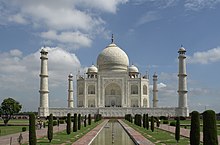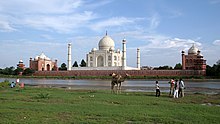Agra

Agrais a city in the northernstateofUttar Pradesh,India.The city is famous for being the capital of theMughalemperors from 1526 to 1658. It is a majortouristdestination for its manyMughal-era buildings such asTāj Mahal,Agra FortandFatehpūr Sikrī,all three of which areUNESCOWorld Heritage Sites.
Climate[change|change source]
Agra is on the Indo-Gangeticplainand has acontinental climate,with long, hotsummersfromApriltoSeptember.During summers dry winds blow in thisregion.Themonsoonmonths fromJulytoSeptembersee about 69cmofrainfallannually.Wintersare fromNovembertoFebruary.Agra is best visited in the months ofOctober,November,FebruaryandMarch,when theaveragetemperatureare between 16 and 25Celsius.
Demographic[change|change source]
In the 2001 Indiancensus,Agra had apopulationof 1,326,000.Malesconsist of 53% of thepopulationandfemalesconsist of 47% of the population. 11% of the population is under 6 years of age. The main language used by the people in Agra isHindifollowed byPanjabi.
History[change|change source]
Agra has a rich history, seen in the monuments around the city. Though the heritage of Agra city is linked with the Mughal dynasty, many other rulers also contributed to the rich past of this city. Modern Agra was founded bySikandar Lodhiin the 16th century. Babar (founder of the Mughal dynasty) also stayed for sometime in Agra and introduced the concept ofsquarePersian-styledgardenshere.EmperorAkbarbuilt the Agra Fort and Fatehpur Sikri near Agra. Fatehpur Sikri remained itscapitalfor around fifteen years after which the city was left isolated in mysteriouscircumstances.Jahangir beautified Agra with palaces and gardens despite spending most of his time inKashmir.
Agra‘s greatest time came whenShahjahanascended to the throne ofMughal Empire.He marked the greatest point ofMughalarchitecture.He built theTaj Mahalin memory of his favourite wifeMumtaz Mahal.In his later years,Shahjahanshifted his capital to the new city ofShahjahanabad(Delhi) and ruled from there.Shahjahanwas removed in1658by his son,Aurangzebwho kept him as prisoner in the Agra Fort. Aurangzeb shifted the capital back to Agra before hisdeath.After the death of Aurangzeb, Mughal Empire could not reach itspeakand many regionalkingdomsemerged. Thepost-Mughaleraof Agra saw the rule of the Jats, Marathas and finally theBritishtaking over the city. After British Raj ended, Agra became part of independent India.
Local transportation[change|change source]
AutoRickshawand Cycle Rickshaw are the maintransportationsin Agra and are available all around the city.
There are Citybusesbut they are infrequent.
Pollutingvehiclesare not allowed nearTaj Mahal,so one needs to take electric Autos orTanga(Tonga) from a few kilometers outside theTaj Mahal.
Places of interest[change|change source]
Taj Mahal

Agra'sTaj Mahalis one of the most famous buildings in the world. It is well known for itsreasonto be built forShah Jahan'sfavoritewife,Mumtaz Mahal.It is one of theSeven Wondersof theworld,and one of threeWorld Heritage Sitesin Agra.
Completed in 1653, theTāj Mahalwas built by theMughalkingShāh Jahānas thegravefor his beloved wife,Mumtāz Mahal.It was built inwhitemarble.It is perhaps India's most fascinating and beautifulmonument.This perfectlysymmetricalmonument took 22 years (1630-1652) of hardlabourand 20,000 workers,masonsandjewellersto build. Along with the building there is landscapedgardens.Thearchitectwho built themonumentis namedPersianarchitect,Ustād 'Īsā.TheTāj Mahalis located on the bank of theYamunaRiver which can be observed fromAgra Fort.
Agra Fort and Fatehpur sikri are some other noteworthy places of interest.
Other websites[change|change source]
- Agra: Things to do & AttractionsArchived2019-04-20 at theWayback Machine
